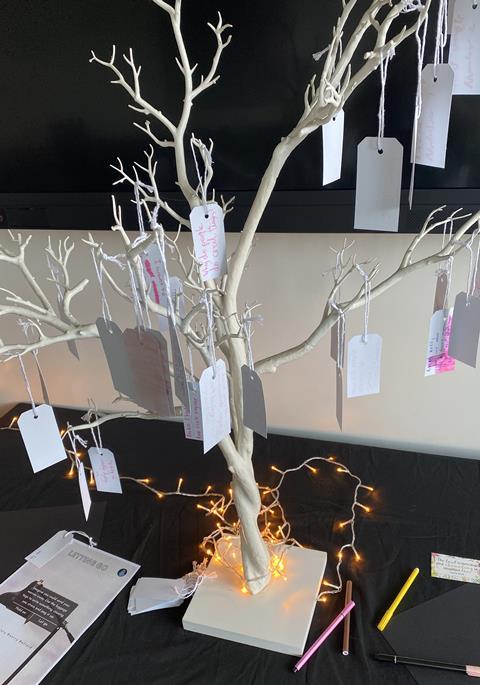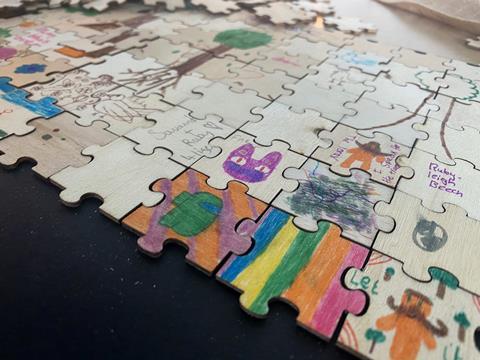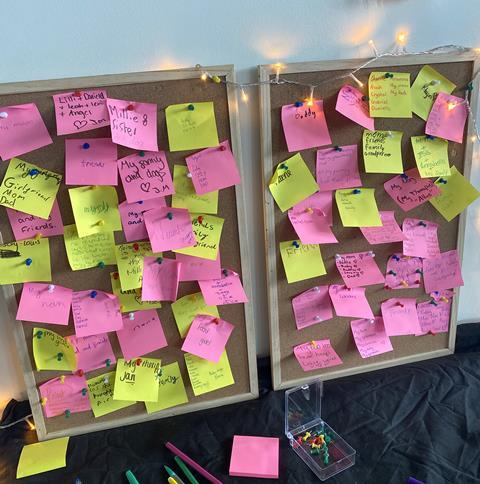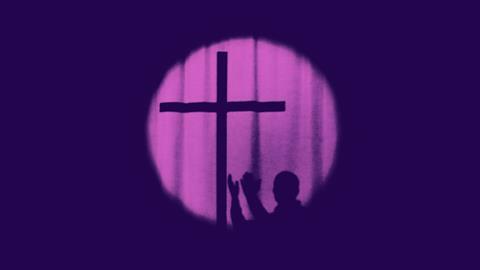They have been around a while but John Prockter believes creating prayer spaces can be a valuable tool in a youthworker’s arsenal
Some of my favourite experiences with young people have been in projects that are traditionally called Prayer Spaces. Like many of the things I write about, there is an excellent website available chock full of ideas that you can visit using the link at the bottom of this post.
Some people who read this article will be well-embedded in the world of prayer spaces. Still, I have found that quite a large number of secondary school workers who either discount prayer spaces as something “my school probably wouldn’t want” or exclude the idea of them altogether because they’re not intellectual enough. I also appreciate that they might present as a financial commitment, difficult to resource. Despite the barriers, let me please encourage you that this is a perfect time to consider introducing prayer spaces into your utility belt of resources.

Why Prayer spaces?
I think prayer spaces are an obvious angle for any primary school worker or children’s worker. The creativity needed is almost written into the DNA of those kinds of positions. It’s probably my fellow youth pastors and secondary school workers who need to catch up, and I’m going to tell you why.
Prior to the Covid-19 pandemic, there was more than just a rumble of an anxiety pandemic on the horizon, and many youth and schools workers had already got on board with pastoral mentoring. In my context, I put together a programme that included reflective resources linked with religious education. Of course, the same resources could be used for student retreats, national reflection periods and during bereavement times.
Essentially, I took the idea of prayer spaces and re-branded them as a resource for reflective practice. This idea isn’t unique; very large Christian charities did and continue to do the same thing. One charity I met this year even charges the schools in their area for the consumable resources students use. They host diverse days that engage the emotions and the mind in explorations of hope, justice, world issues and belief in God.
The picture I’m trying to paint for you is one where thoughtful, reflective spaces can be used in secondary education to great effect. Think of them as diverse experiences to stimulate the heart and mind.

What does it look like?
Take, for example, a room I ran in June this year at one of our schools. We set up stations around quite a large space. The stations were designed for two students each, and we took the young people through a range of experiences, including a physical representation of forgiveness with a block of wood and sandpaper, an exploration of identity with play dough, and home-made snow globes for creating a moment of peace.
During the session, half of the class visited our ten or so reflective stations while the other students debated justice issues, played the Youthscape discussion starter Jenga, and told stories using a series of images. Halfway through the session, we guided the experience with young people moving through different activities, and then at the end we held a whole class discussion. Once the young people left, it was time to reset and start again.

6 key steps to setting up and running your own prayer spaces
This is not an exhaustive training, but I hope it inspires you, and as ever, I would be very pleased to talk to anyone who would like to discuss this further: john@catalystyouthtrust.co.uk
1. Prepare with your schools
I would love to write an article full of resources, but the prayer space website is excellent, which is great news. Look for stations you understand on their site and create yourself a bank of resources: https://prayerspacesinschools.com
The real key is figuring out how to sell the idea to your schools. I would always suggest speaking in terms of reflective practice to secondary schools; it’s an easier concept to explain and a very good starting point for discussion. Perfect opportunities for a prayer space include diversity days, during Christian festivals or as a practical way of teaching lived faith experiences of the Christian faith, which Ofsted is keen to see schools take seriously.
2. Set up the room.
Create space for stations around a room or hall to give the number of young people you’re working with enough space to reflect and leave a gathering area in the centre for group work and discussion.
For symmetry’s sake, imagine you have 20 students in your workshop or lesson. You could run with as little as five stations for two students to experience each, with a group discussion or creative activity for the other half of the class.
How you plan, set up all your stations and practice before you set up in a school.
3. Demystify the experience
Regardless of the environment, the number one job for any youth and children’s worker is to create a welcome that helps tune the young person into the purpose of the activity in front of them as efficiently as possible. This is a crucial dynamic in a tactile ‘prayer space’ room because many of the resources will seem quite unusual.
This is the kind of introduction I recommend. Not that you should copy, but do notice the types of words and phrases I use.
“Hello, welcome to our reflective space. You might generally use this space for a different lesson like Maths or English, but today, we’ve set up a range of activities to help us better understand three key things. 1. Christian belief about prayer, 2. the importance of experiencing peace and 3. how to learn healthy ways to express ourselves when we’re finding life difficult.
For me, these resources feel like a reflection of my faith in Jesus, but today, I’m not asking you to try and understand or copy my experience of faith. Today you’re going to have an objective look at what it means for Christians to pray, and of course, because we’ve also come here with different beliefs and perspectives, we should expect to find ourselves responding very differently, which is also the point of this activity.”
4. Explain the purpose of each station
Once the young people and you are on the same page, it’s important to briefly walk around the room to explain your expectations of how the young people should behave. Prayer space resources, for example, are often relatively easy to break or push over.
When you explain each station, clearly explain how a Christian might use the resource and how the student might also benefit. For example, if you used a resource to help young people understand the purpose of saying sorry, you might say
“Christians say sorry to God because that’s how we grow closer to Him, making a clear decision to turn our backs on behaviour or attitudes that hurt us, and him. But today, you might choose to say sorry for something or to someone to feel like a weight has been lifted from your shoulders. Learning to say sorry is an important part of growing up, making sure you don’t end up feeling disappointed or that you have to hide things all the time.”
5. Release the young people to independent learning
I’d like to say that it’s a given we wouldn’t offer to pray with young people in education, but it’s important I write this in black and white. The purpose of this type of experience is to allow the young people space to respond to the activity in an independently reflective way.
Young people will have questions, but those questions should be answered without further invitations for deeper religious activity or invitation.
6. Debrief honestly
The reality of self-guided learning and tactile spaces is that some young people will hate them. When you discuss the experience, ask the young people to tell you what they loved, disliked and even what they didn’t understand. An honest discussion like that will lead to meaningful questions you’ll want to answer.












































